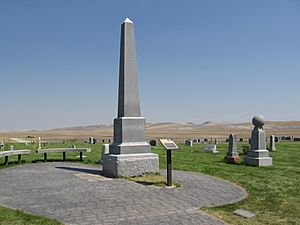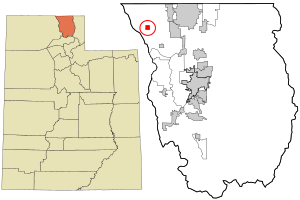Clarkston, Utah facts for kids
Quick facts for kids
Clarkston, Utah
|
|
|---|---|

The Martin Harris Gravesite in Clarkston is listed on the National Register of Historic Places
|
|

Location in Cache County and the state of Utah.
|
|
| Country | United States |
| State | Utah |
| County | Cache |
| Founded | 1864 |
| Named for | Israel Justus Clark |
| Area | |
| • Total | 0.93 sq mi (2.40 km2) |
| • Land | 0.93 sq mi (2.40 km2) |
| • Water | 0.00 sq mi (0.00 km2) |
| Elevation | 4,882 ft (1,488 m) |
| Population
(2020)
|
|
| • Total | 749 |
| • Density | 797.41/sq mi (307.98/km2) |
| Time zone | UTC-7 (Mountain (MST)) |
| • Summer (DST) | UTC-6 (MDT) |
| ZIP code |
84305
|
| Area code(s) | 435 |
| FIPS code | 49-13190 |
| GNIS feature ID | 2413207 |
Clarkston is a small town in Cache County, Utah, in the United States. In 2020, about 749 people lived there. It's part of the larger Logan, Utah-Idaho area. Every June, Clarkston celebrates "Pony Express Days" with a community event.
Clarkston is famous as the last home of Martin Harris. He was one of the "Three Witnesses" of the Book of Mormon. He is buried in Clarkston. For many years, a special show about his life was held every other year. This show stopped in 2018.
Many people who live in Clarkston enjoy seeing local animals. These include mule deer, sharp-tailed grouse, and pheasant.
Contents
History of Clarkston
The town of Clarkston was planned out in 1864. It was named after Israel Justus Clark. He was an early settler and the first leader of the local branch of the Church of Jesus Christ of Latter-day Saints.
Early Settlers and Challenges
The first settlers built their homes east of where Clarkston is today. This area was known as "the flat." But they had problems with water quality and people getting sick. So, they moved the town to a higher place. This new spot was closer to City Creek and other fresh springs.
The settlers also tried "dry farming" north of town. This is a way of growing crops without much rain. In 1866, the settlement was left empty for a short time because of issues with Native Americans. Later, the settlers made an agreement with Indian John, a chief under Washakie.
Growth and Community Life
A local church group, called a ward, was started in Clarkston in late 1867. William F. Rigby became its first bishop. In 1910, a brick meetinghouse was built for the community. By 1930, Clarkston had a population of 570 people.
Many families were among the first to settle here. These included the families of Israel J. Clark, James Myler, William Ricks, and others. There were also the Thompson and Hansen families, A. W. Heggie, and more.
Staying in Clarkston
In 1869, many settlers thought about leaving Clarkston. The winters were very harsh with lots of snow. Many decided to move to the area that is now Newton, Utah.
However, a few people chose to stay in Clarkston. Some who had left even came back. Because of these people, Clarkston became a permanent town. There was a discussion about whether to keep the name Clarkston for the old town or give it to the "New Town."
Geography and Climate
Clarkston covers about 1 square mile (2.4 square kilometers) of land. There is no water area within the town limits. A tall mountain called Gunsight Peak rises above Clarkston. It is 8,244 feet high.
Clarkston usually has about 219 sunny days each year. The town gets about 18 inches of rain annually. It also sees a good amount of snow, averaging 62 inches per year.
Population Over Time
| Historical population | |||
|---|---|---|---|
| Census | Pop. | %± | |
| 1870 | 153 | — | |
| 1880 | 464 | 203.3% | |
| 1890 | 440 | −5.2% | |
| 1900 | 475 | 8.0% | |
| 1910 | 564 | 18.7% | |
| 1920 | 528 | −6.4% | |
| 1930 | 570 | 8.0% | |
| 1940 | 579 | 1.6% | |
| 1950 | 526 | −9.2% | |
| 1960 | 490 | −6.8% | |
| 1970 | 420 | −14.3% | |
| 1980 | 562 | 33.8% | |
| 1990 | 645 | 14.8% | |
| 2000 | 688 | 6.7% | |
| 2010 | 666 | −3.2% | |
| 2020 | 749 | 12.5% | |
| U.S. Decennial Census | |||
In 2000, there were 688 people living in Clarkston. There were 206 households, and 172 of these were families. About 47% of households had children under 18 living with them. Most households (76.7%) were married couples living together.
The average household had 3.34 people, and the average family had 3.78 people. The population was quite young, with 35.5% of residents under 18 years old. The median age in the town was 28 years.
Notable People from Clarkston
- Martin Harris – A pioneer in the Mormon faith.
- William Williams Henderson – An important educator.
- LaFarr Stuart – Known for his work in computer music.
See also
 In Spanish: Clarkston (Utah) para niños
In Spanish: Clarkston (Utah) para niños

